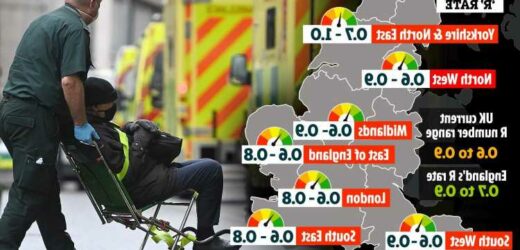THE official coronavirus R rate has dropped for the sixth week in a row, and could be as low as 0.6.
It comes as cases plummeted by a third in a week, and 50 per cent in a fortnight.
🦠 Read our coronavirus live blog for the latest news & updates…
The R rate – which represents the number of people an infected person will pass Covid onto – is now between 0.6 and 0.9 across the UK, Sage said today.
It's the lowest R range seen since the Government first started publishing the figures in May 2020.
Meanwhile, the Office for National Statistics (ONS) infection survey found 481,300 people in England are currently infected, the equivalent of one in 115 or less than one per cent of the population.
It's a 30 per cent decrease from the estimate the week prior, of 695,400 – or one in 80.
And it is the lowest figure since November 29 to December 5, when the estimate also stood at one in 115 people.
Professor Kevin McConway, Emeritus Professor of Applied Statistics, The Open University said the update on the R rate, coupled with the evidence from the React study published this week was "more good news".
He said: "Things are definitely moving in the right direction, and fairly fast. But there is still a long way to go.
"Vaccinations will help more and more, but things are nowhere near back to normal yet and won’t be for a long time."
It comes as:
- Brits told get Covid test if you feel ill in ANY way amid fears new variants cause different symptoms
- Maps reveal potent pockets of Covid in England’s biggest cities where cases are still rampant
- Boris Johnson to finalise lockdown roadmap this weekend before big Monday reveal – as Wales unlocks from Monday
- Over-40s ‘to get Covid vaccine by end of March but no priority for key workers’
- The 13 areas where Covid cases are still rising – is yours on the list?
Last week the R number across the UK was estimated to be between 0.7 and 0.9, with the rate across England the same.
When the R is below 1, it means transmission is low enough for the epidemic to shrink – but greater than 1, it suggests the outbreak is growing.
The R rate peaked in the week of January 8, when it was between 1 and 1.4. It slowly rose from a low of 0.8 to 1 at the start of December.
Sage states that R is a lagging indicator and that the estimates "cannot account for the most recent policy changes, nor changes in transmission that have not yet been reflected in epidemiological data".
The estimates are based on data available up to February 15, including hospital admissions and deaths.
Sage warned that prevalence of the virus “remains high” and that “it remains vital that everyone continues to stay at home in order to keep the R value down, protect the NHS and help save lives”.
Sage estimates the R rate is still 0.7 to 0.9 in England.
It is lowest in the East, London and South East, at 0.6 to 0.8.
And it is highest in North East and Yorkshire – the only region where it could be at 1 (0.7 to 1).
Meanwhile, the growth rate is -6 per cent to -3 per cent, meaning the size of the outbreak is shrinking by as much as six per cent each day.
Last week this figure was -5 per cent to -2 per cent. It has not been growing since the week to January 15.
INFECTION RATES
Data published by the ONS today stated that 481,300 people had Covid in England in the week to February 12, the equivalent of one in 115 or less than one per cent of the population.
This means that cases of the virus have fallen by close to a third in just one week.
It's a 30 per cent decrease from the estimate the week prior, of 695,400 – or one in 80.
And it is the lowest figure since November 29 to December 5, when the estimate also stood at one in 115 people.
Infections also went down by around 30 per cent in Wales and Northern Ireland, to 24,600 and 17,800 cases, respectively, and 17 per cent in Scotland, to 29,200.
The ONS Infection Survey swabs thousands of people every week to track the outbreak.
It does not give estimates of people in care homes, hospitals or prisons – only private homes.
It found that North-west England had the highest proportion of people of any region in England likely to test positive for coronavirus.
Around one in 85 people in the region were estimated to have had Covid-19 in the week ending February 12.
For London the estimate was one in 100, and for the West Midlands it was one in 110.
The other estimates are one in 120 people for the East Midlands and for Yorkshire and the Humber; one in 125 people for eastern England; and one in 135 for north-east England, south-east England and south-west England.
In Wales, around one in 125 people are estimated to have had Covid between February 6 and 12 – down one in 85 for the previous week.
In Northern Ireland, the ONS estimates around one in 105 people had Covid between February 6 and 12, down from one in 75.
The estimate for Scotland is around one in 180 people, down from one in 150.
The estimates from Sage and the ONS come after the experts at the Covid Symptom Study App revealed their R rate prediction of 0.9.
They state that the fall in daily new cases has begun to slow with R values moving back towards 1.0 with most regions at 0.9.
Their app estimates suggest that since January, cases have fallen by 80 per cent – but that in the last week, symptomatic cases have come down by only five per cent.
What does R rate mean?
R0, or R nought, refers to the average number of people that one infected person can expect to pass the coronavirus on to.
For example, if a virus has an R0 of three, it means that every sick person will pass the disease on to three other people if no containment measures are introduced.
Scientists use it to predict how far and how fast a disease will spread – and the number can also inform policy decisions about how to contain an outbreak.
It's also worth pointing out that the R0 is a measure of how infectious a disease is, but not how deadly
Lead scientist of the app, Professor Tim Spector said that although new cases have fallen for six weeks in a row in the last few days the rate of decline has plateaued.
He said: "This is mainly true in places like Scotland, Wales and the Midlands compared to London and the East.
"It’s unclear why this is happening, although people relaxing their guard after vaccination or altering behaviour in the cold weather are possible."
He did however add that it was encouraging that hospital admission were falling and are lower than the peak in January.
Last month there were around 37,000 people in hospital with Covid in the UK with 4,032 on ventilators.
Data from the government's coronavirus dashboard shows that this has dropped off significantly.
Most read in Health News
CARE FREE All the Covid rule changes coming in TODAY – with huge boost for families
Calorie-counting £20 smart watch for kids 'encourages eating disorders'
I'm stuck with bizarre Covid side-effect a MONTH after testing positive
Combining lime with Viagra makes drug up to four times more potent
At present there are 20,156 patients in hospital with Covid-19 and 2,614 requiring support from a ventilator.
Prof Spector added: "With cases still falling in the at-risk age groups and the vaccination roll out continuing there is still reason to be hopeful – but we clearly can’t be complacent."
The promising data is yet more proof that the Covid outbreak is shrinking, and bodes well for this weekend when the Prime Minister sets out the "roadmap" out of lockdown.
Boris Johnson's announcement on Monday evening is set to reveal schools will open on March 8, and the reopening of non-essential shops will follow in a "cautious" move to lift restrictions.
Source: Read Full Article











